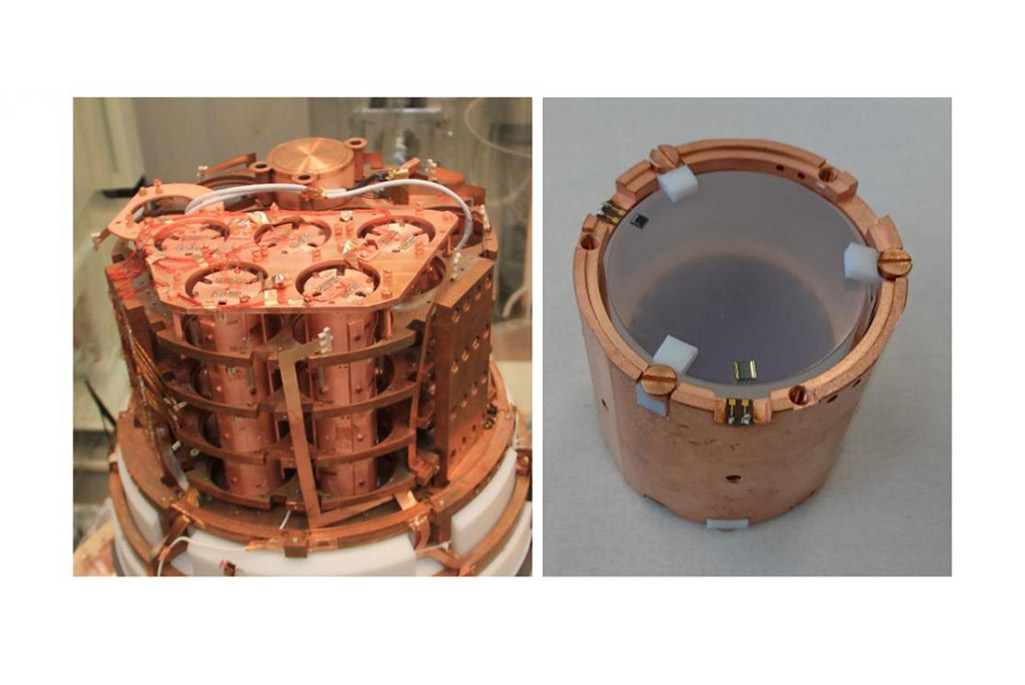In a new paper published in Physical Review Letters, the CUPID-Mo Collaboration reports on the most precise measurement of the two-neutrino double beta (2νββ) decay rate and the spectral shape in Mo-100. For the first time, they have also been able to constrain the higher-order parameters describing the nuclear matrix elements. Their conclusions show that the full structure of nuclear excitations has to be taken into account at the achieved level of precision (±1.6%), going beyond previous commonly employed approximations. The analysis also places constraints on the effective axial-vector coupling gA, indicating that it is not quenched (or not quenched as much) as previous measurements have suggested. This inference is important for the projections of the sensitivity of next-generation, ton-scale neutrinoless double beta (0vββ) decay experiments.
Yury Kolomensky, a senior faculty scientist in the Nuclear Science Division and a professor of physics at UC Berkeley, was one of the lead Berkeley Lab contributors to these new results, providing scientific guidance for the current paper. “Our results demonstrate that the measurements of a very rare process, double beta decay, are entering the precision era,” says Kolomensky. ”We also show how constructive collaborations between theorists and experimentalists can bring new insights on the structure of the atomic nucleus, which have implications on our understanding of the history of the Universe.”
In addition to providing the cryogenic temperature sensors that are crucial for the experiment, and supporting its data taking, Berkeley Lab and UC Berkeley campus staff are leading the data processing and analysis for CUPID-Mo. Benjamin Schmidt (former Berkeley Lab postdoc) was the previous analysis coordinator, and Bradford Welliver (a UC Berkeley research scientist affiliated with Berkeley Lab) is the current analysis coordinator. This data analysis and the paper were led by Toby Dixon (a former Berkeley Lab affiliate and UC Berkeley undergraduate).
CUPID-Mo is a pilot experiment searching for zero-neutrino double beta (0vββ) decay in the nucleus of Mo-100. Conceived by scientists in France and operated at the Modane Underground Laboratory in the French Alps, the experiment has deep connections to Berkeley. With seed funds from a France-Berkeley Fund grant, Berkeley Lab researchers have been key contributors to CUPID-Mo’s operation and science since the experiment’s inception and launch in 2017 (and its first results, reported in 2020, achieved record precision).
CUPID-Mo is unique in another aspect in that its experimental precision requires new theoretical approaches and detailed calculations in order to describe the data. Working with theorists from Slovakia, Czech Republic, Finland, and Italy, CUPID-Mo is able to test common approximations and deduce new insights in the interplay between weak and strong interactions inside the atomic nucleus. Developing a better understanding of the part that nuclear matter plays in rare nuclear processes will be key to interpreting the results from the next-generation ton-scale 0vββ experiments.
Physicists study the phenomena 0vββ decay (an as yet unobserved nuclear process) and 2νββ decay in order to better understand the process of how matter was created in the early universe, and also to unravel the mystery of the staggering imbalance of matter and anti-matter. CUPID-Mo’s experimental design is an important step in the worldwide quest for this matter-creating process. Several projects and hundreds of scientists worldwide use different nuclei for their experiments (e.g. the CUORE project searches for these phenomena in the nuclei of TeO2 crystals). Of all of the elements in our current periodic table, only about a dozen would be applicable for this kind of investigation.
For CUPID, molybdenum was chosen because of its unique nuclear structure in which the rate of the double beta decay is enhanced. The 0νββ decay signature is a peak in the sum energy spectrum of the two emitted electrons. In Mo-100, this peak is expected at 3034 keV, well above the bulk of the environmental radioactivity carried by gamma rays. The remaining dominant source of background in this region consists of alpha particles, and these can be rejected (and thus easily eliminated as ‘noise’ in the experimental date) in CUPID-Mo’s Li2MoO4 scintillating bolometers, thanks to the simultaneous measurement of scintillation and heat. In fact, alphas emit much less light than betas for the same heat energy. These features allow the CUPID-Mo technology to approach a zero background condition, even for large-scale experiments.
Read More:
Measurement of the 2νββ Decay Rate and Spectral Shape of Mo-100 from the CUPID-Mo Experiment
October 18, 2023 / C. Augier et al. (CUPID-Mo Collaboration) / Physical Review Letters
